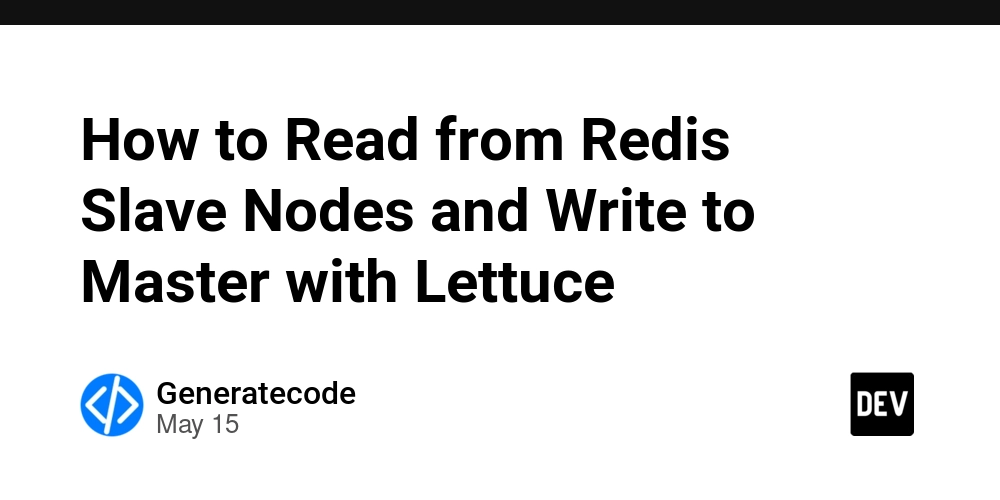How to Read from Redis Slave Nodes and Write to Master with Lettuce
Introduction In modern applications, Redis serves as a powerful in-memory data structure store, often used for caching and real-time analytics. When utilizing Redis in a master-slave configuration, it's essential to know how to read data from slave nodes and write to the master node effectively. In this article, we will explore how to perform these operations using the Lettuce client in Java, leveraging its asynchronous and non-blocking capabilities. Understanding Redis Master-Slave Architecture Before we dive into the code, it's important to understand how Redis handles data in a master-slave architecture. In this setup, the master node is responsible for all write operations, while the slave nodes can handle read requests. This configuration helps in load balancing, thereby improving performance and availability. Why Use Lettuce? Lettuce is a scalable Redis client for Java that allows for both synchronous and asynchronous interactions, making it an excellent choice for high-performance applications. Its easy-to-use API makes it straightforward to connect to Redis instances and manage data across master and slave nodes. Prerequisites To follow along with this article, you need: JDK 8 or higher Maven (to manage dependencies) A Redis instance running with at least one master and one slave node Adding Lettuce to Your Maven Project Include Lettuce as a dependency in your pom.xml file: io.lettuce.core lettuce-core 6.1.5 Make sure to check Maven Central for the latest version. Step-by-Step Code Example Step 1: Connect to Redis Master and Slave Nodes First, set up your Lettuce connection to both the master and the slave Redis nodes. Create a RedisClient for each node. import io.lettuce.core.RedisClient; import io.lettuce.core.api.StatefulRedisConnection; import io.lettuce.core.api.sync.RedisCommands; public class RedisExample { private static final String MASTER_URL = "redis://localhost:6379"; // Master node private static final String SLAVE_URL = "redis://localhost:6380"; // Slave node public static void main(String[] args) { // Connect to Redis Master RedisClient masterClient = RedisClient.create(MASTER_URL); StatefulRedisConnection masterConnection = masterClient.connect(); RedisCommands masterCommands = masterConnection.sync(); // Connect to Redis Slave RedisClient slaveClient = RedisClient.create(SLAVE_URL); StatefulRedisConnection slaveConnection = slaveClient.connect(); RedisCommands slaveCommands = slaveConnection.sync(); // Your code for interacting with Redis goes here // Cleanup masterConnection.close(); masterClient.shutdown(); slaveConnection.close(); slaveClient.shutdown(); } } Step 2: Read Data from the Slave Node Once connected, you can issue read commands to the slave node. Here's how you can do that: // Example of reading data from the slave node String value = slaveCommands.get("myKey"); if (value != null) { System.out.println("Value from Slave: " + value); } else { System.out.println("No value found for key 'myKey' in Slave."); } Step 3: Write Data to the Master Node Now, let's add data to the master node. Writing operations can only be performed on the master: // Example of writing data to the master node String key = "myKey"; String newValue = "myData"; masterCommands.set(key, newValue); System.out.println("Value written to Master: " + newValue); Error Handling It's important to implement proper error handling during connections and operations. Make sure to catch exceptions and handle potential failures gracefully: try { // Redis operations } catch (Exception e) { System.err.println("Error: " + e.getMessage()); } Frequently Asked Questions Can I write to a Redis slave node? No, write operations can only be performed on the master node in a Redis master-slave architecture. Slave nodes can only handle read requests. What happens if the master node goes down? If the master node goes down, you can use Redis Sentinel or configure your application logic to handle switchover to a new master node. How does Lettuce handle connections? Lettuce manages connections in a thread-safe manner, supports both synchronous and asynchronous operations, and allows you to easily switch between mode granularly. Conclusion Using Lettuce with Redis allows you to efficiently manage data in a master-slave configuration. By connecting to both the master and slave nodes, you can perform read operations on the slave while ensuring write operations are safely executed on the master. This strategy enhances application performance by distributing the load effectively. Now that you understand the basic operations of reading and writing in Redis with Lettuce, you can implement this in your applications for better data management and performance.

Introduction
In modern applications, Redis serves as a powerful in-memory data structure store, often used for caching and real-time analytics. When utilizing Redis in a master-slave configuration, it's essential to know how to read data from slave nodes and write to the master node effectively. In this article, we will explore how to perform these operations using the Lettuce client in Java, leveraging its asynchronous and non-blocking capabilities.
Understanding Redis Master-Slave Architecture
Before we dive into the code, it's important to understand how Redis handles data in a master-slave architecture. In this setup, the master node is responsible for all write operations, while the slave nodes can handle read requests. This configuration helps in load balancing, thereby improving performance and availability.
Why Use Lettuce?
Lettuce is a scalable Redis client for Java that allows for both synchronous and asynchronous interactions, making it an excellent choice for high-performance applications. Its easy-to-use API makes it straightforward to connect to Redis instances and manage data across master and slave nodes.
Prerequisites
To follow along with this article, you need:
- JDK 8 or higher
- Maven (to manage dependencies)
- A Redis instance running with at least one master and one slave node
Adding Lettuce to Your Maven Project
Include Lettuce as a dependency in your pom.xml file:
io.lettuce.core
lettuce-core
6.1.5
Make sure to check Maven Central for the latest version.
Step-by-Step Code Example
Step 1: Connect to Redis Master and Slave Nodes
First, set up your Lettuce connection to both the master and the slave Redis nodes. Create a RedisClient for each node.
import io.lettuce.core.RedisClient;
import io.lettuce.core.api.StatefulRedisConnection;
import io.lettuce.core.api.sync.RedisCommands;
public class RedisExample {
private static final String MASTER_URL = "redis://localhost:6379"; // Master node
private static final String SLAVE_URL = "redis://localhost:6380"; // Slave node
public static void main(String[] args) {
// Connect to Redis Master
RedisClient masterClient = RedisClient.create(MASTER_URL);
StatefulRedisConnection masterConnection = masterClient.connect();
RedisCommands masterCommands = masterConnection.sync();
// Connect to Redis Slave
RedisClient slaveClient = RedisClient.create(SLAVE_URL);
StatefulRedisConnection slaveConnection = slaveClient.connect();
RedisCommands slaveCommands = slaveConnection.sync();
// Your code for interacting with Redis goes here
// Cleanup
masterConnection.close();
masterClient.shutdown();
slaveConnection.close();
slaveClient.shutdown();
}
}
Step 2: Read Data from the Slave Node
Once connected, you can issue read commands to the slave node. Here's how you can do that:
// Example of reading data from the slave node
String value = slaveCommands.get("myKey");
if (value != null) {
System.out.println("Value from Slave: " + value);
} else {
System.out.println("No value found for key 'myKey' in Slave.");
}
Step 3: Write Data to the Master Node
Now, let's add data to the master node. Writing operations can only be performed on the master:
// Example of writing data to the master node
String key = "myKey";
String newValue = "myData";
masterCommands.set(key, newValue);
System.out.println("Value written to Master: " + newValue);
Error Handling
It's important to implement proper error handling during connections and operations. Make sure to catch exceptions and handle potential failures gracefully:
try {
// Redis operations
} catch (Exception e) {
System.err.println("Error: " + e.getMessage());
}
Frequently Asked Questions
Can I write to a Redis slave node?
No, write operations can only be performed on the master node in a Redis master-slave architecture. Slave nodes can only handle read requests.
What happens if the master node goes down?
If the master node goes down, you can use Redis Sentinel or configure your application logic to handle switchover to a new master node.
How does Lettuce handle connections?
Lettuce manages connections in a thread-safe manner, supports both synchronous and asynchronous operations, and allows you to easily switch between mode granularly.
Conclusion
Using Lettuce with Redis allows you to efficiently manage data in a master-slave configuration. By connecting to both the master and slave nodes, you can perform read operations on the slave while ensuring write operations are safely executed on the master. This strategy enhances application performance by distributing the load effectively. Now that you understand the basic operations of reading and writing in Redis with Lettuce, you can implement this in your applications for better data management and performance.



















![[DEALS] The 2025 Ultimate GenAI Masterclass Bundle (87% off) & Other Deals Up To 98% Off – Offers End Soon!](https://www.javacodegeeks.com/wp-content/uploads/2012/12/jcg-logo.jpg)



-Olekcii_Mach_Alamy.jpg?width=1280&auto=webp&quality=80&disable=upscale#)






















![Air Traffic Controller Claps Back At United CEO Scott Kirby: ‘You’re The Problem At Newark’ [Roundup]](https://viewfromthewing.com/wp-content/uploads/2025/05/scott-kirby-on-stage.jpg?#)

































